Chapter “On interior geographical margins in China:
Exploring Chinese contemporary art practices
that connect to Tibet, Inner Mongolia and Xinjiang”
in Book China en el arte y la producción cultural
contemporánea global, CERAO, Spain, 2022
On interior geographical margins in China:
Exploring Chinese contemporary art practices that connect to Tibet, Inner Mongolia and Xinjiang
Mei Huang
Introduction
This paper is a brief resume of my research about how contemporary art represents the margins of the society in China. How to define the concept of margins in China? It is always a complex question. In order to answer this, firstly we can explore the discourse of periphery or borders in a broader perspective. We live in a time and space in which borders, both literal and figurative, exist everywhere (Alejandro Morales, 1995). According to James Anderson and Liam O’Dowd, “Going beyond definitions, borders have material and symbolic uses (James Anderson & Liam O’Dowd, 1999:595).” From the material point of view, it has very obvious physical presence, such as frontier or regional borders, to protect from those who are called ‘outsiders’ and mark the limits of certain ‘community’ or ‘society’. In symbolic aspect, margins function as “the material embodiment of history” (James Anderson & Liam O’Dowd, 1999) or in another word “time written in space” (Rupnik, 1994), which can be understood as socio-political and cultural peripheries. This article will focus to discuss how contemporary art represents the margins of China in one major viewpoint: the interior geographical border — those regions with strong historical, socio-political, cultural and ethnic characteristics, such as Tibet, Inner Mongolia and Xinjiang.
The upcoming sections will link and co-analyze the contemporary art practices, in-depth interviews from artists and curators together with the current interior frontier issues in China. As painter Carroll Dunham said, “art is a craft-based tool for the study of consciousness (Carroll Dunham, 1972)”. It is “a visual language that with the power to tell us more in the blink of an eye than we might learn in hours of listening or reading (Jerry Saltz, 2020:12)”. Art connects our instincts, memories, self-identities, cultural backgrounds and many more at unconscious level. It creates “a sort of alchemical transformation in the viewer’s memory and body, forming news synapses in the brain, becoming an actual part of their own experiences of consciousness in the world (Jerry Saltz, 2020:45).” Through piecing fragments and clues, this research aims to map, transform and document art projects into a visual archive of the emerging socio-political, historical and cultural debates in marginal issues. Likewise, it is hoped that through such objective statements and research, enables different cultures and groups to break down boundaries, abandon discrimination and prejudice, and communicate in diversity, equality and sincerity. Starting with the analysis of works and exclusive interviews with artists and curators from different generations both in and outside China. These will bring us unique perspectives and reflections toward current situation in the peripheries of Chinese society.
Tibet, Inner Mongolia and Xinjiang provinces have the largest interior frontiers in China. These margins both look inwards and outwards: they “simultaneously unify and divide, include and exclude (James Anderson & Liam O’Dowd, 1999:596)”. It is argued that the nation-state ideal of cultural homogeneity and centralization are both confirmed and interrupted at the border; and borders and border regions display many dimensions of differences, inequality towards economical, political, cultural and social aspects (James Anderson & Liam O’Dowd, 1999). Furthermore, a part from the border issues, the regions also have significant ethnic characteristics. Their cultures and traditions are very different from the Han ethnic group (which accounted for 91.51% of the total population of the country). A series of modern policies have also exacerbated the differentiation. This can be traced back to the Qing Dynasty (Mark Elliott, 2002), the Republic of China (Liu Xiaoyuan, 2018), as well as policies in the early days of the founding of PRC and after the Chinese economic reformI (Wang Ke, 2017). It is precisely because of these long-standing and complicated reasons what makes this research extremely interesting: it has been gradually discovered that in recent years, many outstanding contemporary artists and curators are also paying attention to such issues and they show very distinct perspectives and starting points. In this chapter , the study cases that related to Tibet, Inner Mongolia and Xinjiang will be discussed through the work of artists and curators such as Lu Nan, Chyanga (Qin Ga), NiNi Dongnier, Hou Hanru and Liu Yujia.
Four Seasons: an undiscovered documentary of Tibet
Four Seasons (1996-2004) is the final part of Lu Nan’s Trilogy, after The forgotten people (1989 -1990) which illustrated the extreme harsh living condition of the Chinese psychiatric patients and the detailed records of Catholic Community On the Road (1992-1996). Lu (born in 1962) often describes and compares the volumes with the Divine Comedy (1472) from Dante Alighieri, if the previous two are the Inferno and the Purgatorio, then the Four Seasons would be the Paradiso in his consideration: a world that is “pure” and utopic without any “filthy” from the human desire of over-consumerism and capitalism. But why is that? Is it true? The story starts from how people look at Tibet and consider how is it represented.
Tibet always appears as a spiritual place with holy light, in some extend like Jerusalem in the Buddhism context. When you search the location, this is what shows in front of your eyes – the Potala Palace in the city of Lhasa, white snow and mountains, lights from the clouds and temples with monks dressed in reds. It is a perfect place for escaping the reality towards urban citizens. Or, a full exotic and romantic orientalised region that rich tourists would like to go. Picturing colorful little flags wing from the clear sky, those mysterious patterns on the wall, a naturalistic combine rural connection; simple and traditional people with tan faces smiling to you in their ethnic dresses. All of these can be found in peoples’ cameras.
But this is only an imaginary Tibet from one’s perspective, which depends on his or her information from the media, it has or has not anything to do with the real place. This is what Lu Nan tries to break through his photographs. He did not have many expectations towards what he was going to find, “I just go to where people live,” he said. Lu is a man not so good at words, but live with his own set of principles for dealing with people, he does much more than what he speaks. A taciturn and outlying person, very suiting for the topic. Instead of going with a team or hire a translator, he decided to stay in Lhasa more than two months, where he learned Tibetan himself. Lu seemed not very interested in what everyone else was doing, not even visiting the Potala Palace once, he knew and always knows what he wants.
Each time when Lu arrived to a place and planned to work, the first thing was to buy a provincial map. Surprisingly, in the interview, he has denied that he did detailed research before took his camera and went out to the field. He only used a scale to calculate on the map: the place that he could find more than six villages in the map within two and half hours walking speed (in the speed no less than 7.5 kilometers per hour) was the destination he looked for. The trip starting from the south village of Lhasa, Qonggyai, then slowly moved to the west, following the latitude and longitude of the map, finally located to four other villages in a small square shape: Lamei, Dinggyê, Ngamring and Tingri county. All of these locations are close to the border of Nepal and Bhutan. From 1996 to 2004, he has been to these locations nine times, every period lasted three to four months. In the last two terms, from August 2002 to May 2004, Lu worked fifteen months in total. It is worth noting that all these above-mentioned locations have no other ethnic communities and the only communication language that was being used was Tibetan.
Four Seasons (1996-2004) photographs the harvest processes in Tibet, very simple and lively daily routines of farmers. During the project, the complete spring planting has been shot twice, and the autumn harvest has been documented four times. Lu slept in the village councils at night, spent his evening just by reading a few books he brought with him; and during the day time, he stayed in the farmland together with locals. “Those farmers had endless work from morning to night throughout the year. Excepts for fixed tasks such as spring planting and autumn harvest, serving and weaving, the work they did the most was twisting wool into threads.” Lu described. If his The forgotten people is related to pain and suffering, and On the Road is about how religious influences and purifies one’s mental health, then Four Seasons is toward a peaceful attitude of living state. According to Buddhism, Lu believes, the heaven is not an abstract concept, but a concrete reality: when people’s minds are tranquil and in a peaceful state, they are living in the Paradiso and happiness.
Looking at Women gleaning wheat (2003), for instance, two women dressed in old and traditional dress hunched over – they were harvesting wheat. The gesture and atmosphere in the photo suddenly reminds me Des glaneuses (1857) from Jean-François Millet, which is now the part of collection at the Musée d’Orsay in Paris. The vision here is broad and open, eyes help us to feel the nippy air and it seems to pass through the skin and noses, perhaps even with the smell of dung from cows and horses. Different from French style landscape, the mountains in the background were bleak, there were no trees, grass or any green. Fingers of the women were rough and chapped; the scribbled straw baskets and dirty old headscarves showed their living and economic conditions. They were very focused, however, the camera captures a still moment, and this moment seems to be eternal.
Women gleaning wheat, from Four Seasons, Lu Nan, 2003
The same concentration can be found in the work A couple working while preparing their meal (2002). With a black and old pot on a broken iron rack, cooking with fire, a young Tibetan couple were rolling wool into threads by their bare hands. The simple and crude stone wall with dirty dust ground floor house was definitely not a very comfortable place to live in the modern life in winter, despite the fact that in 2000 almost all cities and towns in China had already electricity and gas supply, whereas they looked satisfied and peaceful while working. Natural light hit their full cheeks and it made them looked like those Buddha statues in the temple.
A couple working while preparing their meal, from Four Seasons, Lu Nan, 2002
People fixing a plough (2001) is one of my personal favorites in the volume. A family was standing in the field and trying to fix their plough on a yak. Everyone was checking at the progress except the child, he looked at the camera directly with a smile and naughty face. In the background, the sky, mountains and clouds have merged together, it reminds me when you look through a window from a flight, the kind of imagination of living beyond the clouds. It has a big contrast between the heavenly background and the earth, or other word of saying — reality, the contrast of the utopian fascination and melancholy of the unsolved livelihood. A portrayal of vicissitudes.
In rural Tibet, most farmers believe in Buddhism. There are no fixed rituals for their religious beliefs, and religious activities are rarely held. Most families will occasionally invite monks or people who can recite sutras to their homes. Their beliefs are deeply integrated into daily life, and are more reflected in their attitudes towards nature, other creatures, birth, old age, sickness and death. Four Seasons presents the daily life of farmers, as well as non-ritual religious beliefs. For Buddhists, happiness has nothing to do with rich or poor, but with the current peace of mind. The Tibetan farmers live and work calmly and unhurriedly in a tranquil inner state. They are neither trapped by the past nor disturbed by the future. This state that recognized by Buddhism is also incompatible with Epicureanism, Stoicism and Spinozism (Lu Nan, 2019).
People fixing a plough, from Four Seasons, Lu Nan, 2001
Although the living environment of Tibetan farmers was extreme and lacking of resources, with all hardships they have suffered they maintained an optimistic gratitude. Until the end of Four Seasons shooting, every grain that harvested by the farmers from the land belongs to them. Lu does not like to talk about the feelings when he was doing his work, yet, he described the scenes and fragments he experienced. The farmers were living according to the sunlight, they worked when sun rises and slept once the sun sets. Still, the viewpoint of Lu Nan is a perspective of an idealized world in his own way, a side from the real Tibet. As Olivia Laing mentioned: “it is naive to assume that an artist is personally acquainted with their subject matter, that they are not simply a witness to their age, to the prevailing moods and preoccupations of the times (Olivia Laing, 2016:32).” It is rather to be believed that the volume was his own state and what he wanted to demonstrate: a selfless attitude towards focusing, working, thanksgiving and enjoyment of living. Bringing and rising an unintentional flash back from one’s deep memory: a certain smell, a scene in the rain or dusk, the experience that suddenly resurrected in the mind. His works depict the beauty and admiration of the nature, despite that there were many curial realties such living, education, political and economic conditions in Tibet that were not or only partly presented in the photographs.
It is quite unbelievable that these stories were happened around the year 2000, only 22 years before us now. Even though the photographs are timeless and classical, indeed, it is hard to tell when there are no machine, electricity and gas appeared in the whole volume. Considering we are living in the modern time, it is very surprising. It shows the evidences that the deep Tibetan areas were still in a very basic and “primitive” state. Tourist cities such as Lhasa were just a special case of rarely high economic development. This also confirms that a part of Tibetans lived in isolation without outside communication. Tibet is indeed considered geographical, economical and cultural margins in China.
So far, from what can be seen in the photographs, very less signs of ethnopolitics or geopolitical influences can be detected. Written and theoretical descriptions are so different from everyday lives of people. What is obvious here is the essential difference between Han and Tibetan culture and traditions, and the big gap of education and economic conditions, most Tibetans were probably still stuck at the farming age. Under the tranquil and romantic images, it is a complex and real Tibet. There are still much more to explore of course, as it is just a piece of fragment within the whole picture. But there is always a question: is this peaceful life without desire and demand only because of the faith and choice made by oneself, or due to ignorance and lacking of education and economic condition? This may be very different from what the artist and many people want to praise. However, until now, after capitalism and consumerism entered, when the Pandora’s box is opened, will the lives of Tibetans still be like this? Will Tibet remain the holy land in people’s minds? Those are the reflections we may need to think about.
Nomadic ethnography, a self-seeking trip
Starting from the Yuan Dynasty (1271-1368), since Genghis Khan entered China, Chinese culture has been greatly influenced and merged by Mongol culture. Although it has its own language, culture and tradition, different from frontier regions such as Xinjiang and Tibet, Inner Mongolia has a very high degree of integration compared with other ethnic communities in the northwest China. In recent ten years, contrary to the highly urbanized development of Hohhot and surrounding cities, a group of artists (both Inner Mongolian and Han) began to re-discuss the nomad way of living and return to their origins and nature. Inner Mongolian artist Chyanga (born in 1971) is one of the representatives and initiators of this movement.
In the interview, Chyanga often remembers his hometown Alxa Left Banner and Bayannur: the jade green fields, animal like breeze, the delicious fresh meat and the feeling of walking and being exposed to the nature. He is skeptical about visual arts, and believes that art is from personal experiences, feelings and daily-lives, but not any concepts or theories from books. His grandparents frequently told him the old proverb from Genghis Khan: do not hesitate because of the long way, as long as you go, you will arrive. It made him to realize and focus on physical art practices and the relationship with nature in contemporary art. A comfortable way to get along with himself instead of the struggle of adaption to the mainstream society — a nomadic migration, from urban area back to embracing the nature. “It was awakened from the darkness,” he said.
The nomadic dynamic is a circle, a cycle, which means the starting point is also the ending. However, the most important experience is the process, not in a straight line but an arc. In the past fifteen years, I have stayed in Beijing for at most one-third or half of the time each year, yet constantly returning to Inner Mongolia for walking trips. Time has brought many changes. The experience in the process has not all been made into my works. I need this sort of physical perception, and I want to bring it to modern urban living — a contemporary nomadic lifestyle in the city (Chyanga, 2021).
He argues “nomad” is not a noun but a verb. It is a worldview, a perspective on all and everything, a consciousness and a way of thinking, which is closely related to the awareness of one’s flesh and body. Chyanga firmly believes in nomadism. “A belief”, he said. He has been trying and creating more concrete works for the past two decades to reflect these cognitions and senses. Using nomadism as a working method and trying to find out what the specific pivot is, in a continuous, dynamic and unpredictable process. “This process takes time,” as he describes, “it is constructed repeatedly within art creations and events, until its outline and logical structure are gradually depicted (Chyanga, 2021)”. He does not trust that a single work can contain a complete narrative, “Now I find that this process is actually a dynamic circle, sometimes in and out, going back and forth, like a transition in reincarnation”.
The Miniature Long March (2002-2005), as a part of the Long March ProjectII, perhaps is one of Chyanga’s most well-known works. The work contains two parts. In the first part, with a tattooed map on the skin at his back, Chyanga worked with an artist in Beijing to tattoo down the city names when the gallery team has crossed from the road of the Long March. The second part, which is more exciting, he brought his own team to visualize walking progress in the grassland and snow mountain. The work has done in very extreme environments, the place names have been tattooed at his body in each location. Videos and objects during the trip have also been collected as a part of the work. Pain, physical feeling at the time and the experiences of trip have become a group memory within the framework of historical concept. It not only illustrates the relationship between artistic practice and the body, but mixing concepts with the race, ethnic identity, regional borders and self-experiences — a connection that cannot be erased from the vein. Although the artist did not design the aforementioned reflections in advance and on purpose, there was a clear sign in his subconsciousness that was seeking for self-identity.
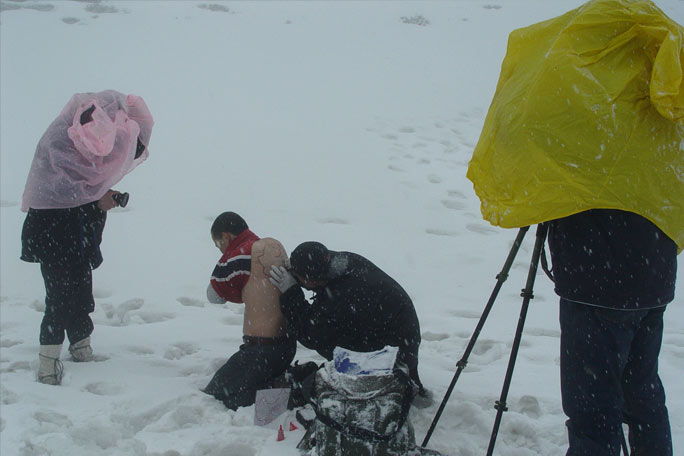
The Miniature Long March working process, Ruijin of Jiangxi province to Luding Bridge of Sichuan Province, Chyanga, 2002
Grassland Fence Project (2014) is a continuation of his inner-seeking. When Chyanga has realized the environmental problem of the grassland in Inner Mongolia, he started many filed research and interviews with locals there. The grasslands in the past had no borders. Now the government distributes the pastures to herders, as land contracting. Therefore, the land is enclosed by fences, it cannot be passed when one demands to pass. The rule is not only applied for human, as well as animals such as sheep and cattle. Nomadism has become a “fixed” pastoralism, and social order has changed nature. Although some herders were aware of the problem, they united to tear down the fence for regional cooperation. However, there were more issues remained and extended. The trips has touched the artist very much. The herders’ experiences may seem ordinary, but they are closely related to the changes in the society. The installations include photographs, flyers, videos and the physical fences that have been taken from the villages are displayed as a whole in the space. It is the fence of reality and between people and nature. It also reminds historical frontier issues in China: from the invisible free boundary to the tangible solidified borders on the map, and various ethnic and cultural-political issues that involved. The great history is the constant repetition in everyday lives.
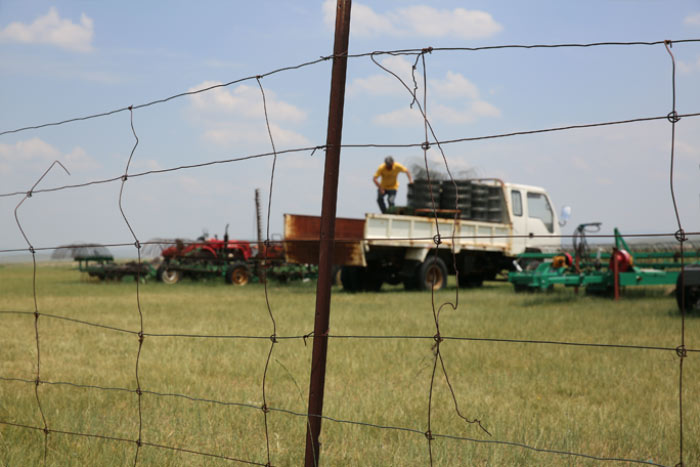
Grassland Fence Project, video installation, various sizes, Chyanga, 2014
NiNi Dongnier, an Inner Mongolian female artist from different generation and background, has a similar but quite distinct view than Chyanga. Dongnier was born in the 80s, she has a very international background: educated in New York, lives and works in Beijing and Vancouver. She is a dancer and visual artist, similar to Chyanga, Dongnier uses her body as media to express. However, Inner Mongolian ethnography is just an offshoot of her practices. She believes that rather than stylized emphasis on a certain identity or attribute, the works should seek more fundamental questions in one’s life (NiNi Dongnier, 2022). Her definitions of identity, gender and ethnicity are resistant.
In my heart, I don’t over-romanticize people from Inner Mongolia. The Inner Mongolians that I observed, some of them who engaged in artistic creations, have a naive perseverance to the so-called outdated and rigid ‘purity’. They use this ‘purity’ to cover up their greed, right of speech, submission and ignorance. For example, towards the topics of whether speaking Mongolian, living in Inner Mongolia, or if someone’s aesthetic style resemble others… I don’t think only herdsmen’s lives are pure ((NiNi Dongnier, 2022).
For Dongnier, Inner Mongolia is a unique spiritual field: a place of birth, a starting point, a perspective, an essential background. It can be observed, with tragic features. “Like a layer of grayscale, contains a certain volume and a sense of weight; it is transcendent,” she said. Looking back on her works in the past, for instance, the early dances such as Winter Pasture (2010), Banquet Dance (2014), Image of Cloud (2016) and Melting River (2016); these practices directly extract the dynamics and picture — the sense of space and atmosphere in her memory. It happened very naturally. Her works include both landscapes of Inner Mongolia and the spatial present of the body within the actual spaces, Dongnier imagines how the field can be combined with the choreography and become a mental state that immersed in the dance.
When she was asked about nomadic culture, Dongnier said it equals faith to her. In her undergraduate and postgraduate dissertations, she researched about The Performance Characteristics of Inner Mongolia Dance and Its Relationship with Shamanism (2008) and A Comparative Ritual Dance Study of the Plains Indians Sun Dance and Inner Mongolian Horqin Andai (2012). During many years she is passionate about near-divine aesthetic, and Nomadic culture for Dongnier has features that close to what Johann Joachim Winckelmann describes about the Greek art: “noble simplicity and silent greatness (Johann Joachim Winckelmann, 1987:64).”
Field Record 4: Every Motion is a Ritual (2021) by NiNi Dongnier is one of my favorite pieces. As a dancer, she did not dance in the video as audiences expected. Instead, Dongnier placed a giant green ball made by pure wool in the wild, and let it flow naturally accompanied by soft sound of wind and chantings of cows and sheep. The high-definition camera makes the mechanism of each hair in the “grass ball” appears on the screen so clearly. The wind touch the ball tenderly, with soft, smooth and light motions, like the touch of stroking fur or grass with spiritual tentacles. This is the dance from nature. In this piece, Dongnier is only an observer, conveying her understanding between nature and ritual to the viewer. “Relax and wait for the wind, ” she said, what a beautiful philosophy.
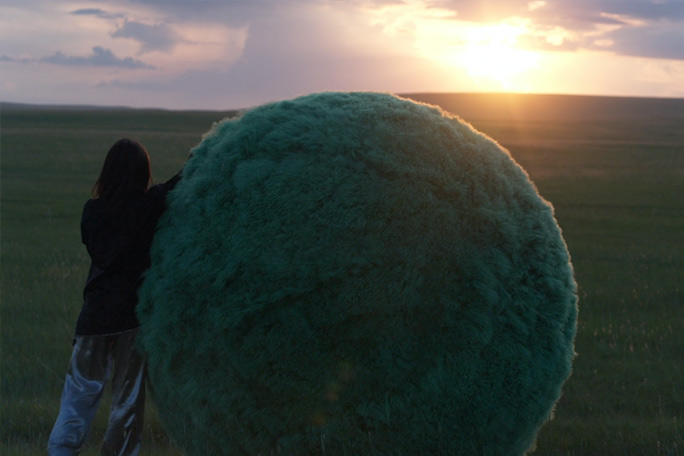
Field Record 4: Every Motion is a Ritual, single channel video, NiNi Dongnier, 2021
Dongnier’s works are deeply inspired by her birthplace, and the relationship and connection between human and nature — an invisible yet powerful gravitational force. The discussion of ethnicity cannot be found in her projects very obviously. She loves and identifies with the tradition, but is resolutely disgusted with the local narrow and exclusive culture. She was, at one point, consciously avoiding ethnicity in her dance and dynamic body languages. “I do not want to be ruled and judged by a certain authority setting or a label, I want to know where my roots are. After the self-seeking progresses, I found out geography, spirits, history and arts in the past of Inner Mongolia has influenced my aesthetic judgment (NiNi Dongnier, 2022).”
Xinjiang: where exotic treasure hunts happen?
Since the Republic of China, art practices from the northern Xinjiang was dominated by traditional Chinese paintings. The southern Xinjiang, where the main Uyghur community gathered, did not have the concept of “painter” and there was no painting figures. There were only a few artisans who used to paint landscaped and patterns that have been strongly influenced by Islamic patterns and religious characteristics (Zeng Qunkai, 2021). Nevertheless, while Xinjiang has recently gained global attention, a large number of new art spaces, festivals and contemporary art have gradually emerged. According to Zeng’s study, the style and expression of most ethnic minority artists in Xinjiang remains at the stage of realism and romanticism which were inspired by the Soviet Union. It is relatively conservative, and to a certain extent refuses to contact and integrate with contemporary art from outside world (Zeng Qunkai, 2021). Of course, the results of this study are subjects that need further verification. Therefore, the research that presents in this part of the article will mainly focus on Han artists and curator as outsiders and observers, and through perspectives of contemporary art to elaborate the current socio-political, cultural and ethic issues in Xinjiang. The first case study in this section is based on a series of in-depth conversations with Hou Hanru, plus the deconstruction of his key concepts and exhibitions in juxtaposition with other relevant theories and current socio-political events and policies. During his decades of practice, Hou (born in 1963) made great contributions towards art globalization discourse, especially about the internationalization of Chinese contemporary art; offering anti-hegemonic discourse and promoting changes of city urbanization and cosmopolitanism in his projects.
Dirty Realism: Liu Xiaodong’s Hotan Project and Xinjiang Research (2012), is a starting and testing ground of Hou by using contemporary art as a media to touch the Xinjiang issue for the first time. The project, designed by him, combined the individual painting practice of Liu Xiaodong and collective investigations of Xinjiang’s multiethnic culture-scape led by Ou Ning. It eventually dealt with a controversial dispute of cultural geopolitics and geopolitical boundaries between Xinjiang province and China. With Liu Xiaodong’s live sketches, oil paintings, photographs, dairy records, a film and a series of interviews and workshops-symposiums with local writers, musicians and architects realized by Ou Ning and his team, Hou aims to present rich and diverse independent cultural voices, as well as an intense social-political reality formed throughout decades of modernization and urbanization policy in the far west part of China. By breaking the inherent ethnical symbols and exotic clichés, he wants to build an open platform for communication and discussion to counter-balance the misunderstandings and lack of contacts between the two regions and people. It is indeed a very pioneering project in the context during the 5th of July 2012III.
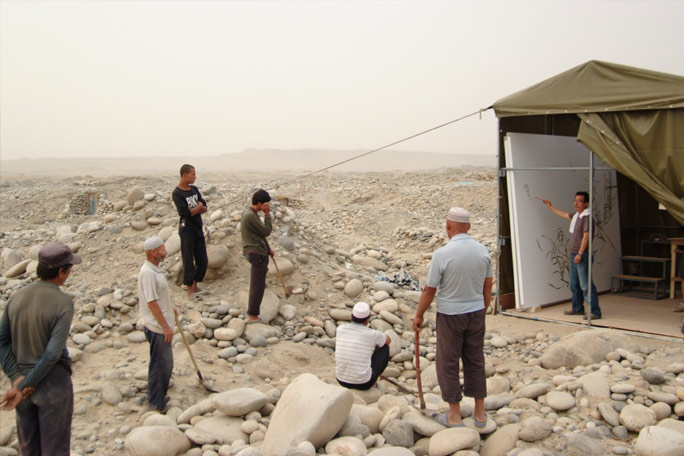
Dirty Realism: Liu Xiaodong’s Hotan Project and Xinjiang Research, photo documentation, 2012
Liu Xiaodong’s paintings in the exhibition are about the daily lives of local people and landscapes in Hotan, especially those toiling to make a living with jade-mining, and his dairies are mostly connected with the feelings and instincts he had during the progress of making the works. A slight and controllable expression of fear and class distance can be detected in his writing, and it is a bit difficult to interpret the intentions of the pieces without reading the curatorial text. Under the brush of Liu, the local people whether standing, looking at the camera, posing or working – as most of his previous academic oil paintings were, skeptically orchestrated. Take Small “West” (2014) as example, one of his few oil paintings in the show. A young couple was walking in the field, the man bowed his head, and the young woman with a smell face looking at the artist (or camera). The tone of the painting is beautiful, harmonious and agile, but also mediocre and flat. Or let us say Mining Jade 1 (2012), several acrylic dots directly painted on the photograph of a group of Uyghur mining in a form of circle, somehow seemed as an assignment or a graffiti with inadvertently. Still, it is brave enough for the willingness to test the topic. The research of Uyghur residential patterns in Xinjiang (2016) has clearly pointed out that Han majority and Uyghur communities are very separated from each other in terms of living and cultural links (James Leibold and Danielle Xiaodan Deng, 2016). Long period misunderstandings and communication gaps thus exist in the region. The fragmentary images of these minorities’ everyday lives are foremost to break the misapprehensions and negative impressions from the majority of the publics.
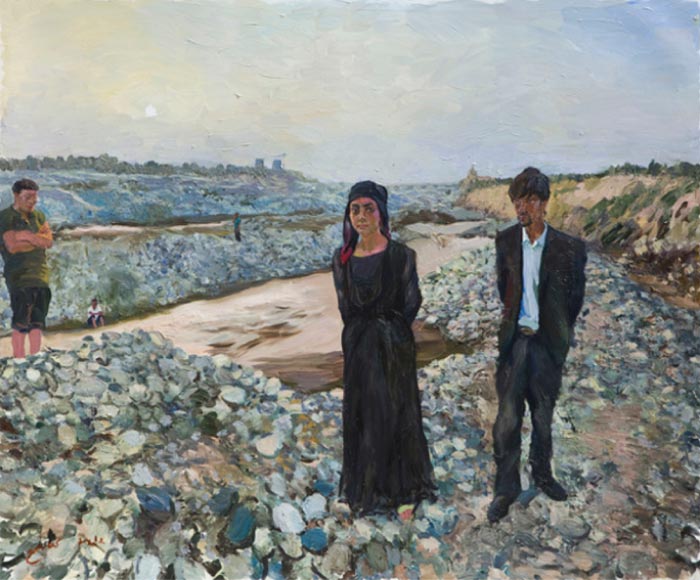
Small “West”, 300 x 250cm, oil on canvas, Liu Xiaodong, 2014
The exhibition view in Urumqi is quite impressive and fit the concept and discussion perfectly. In the dairy of Liu, June 27 2012, he wrote:
We went to the Exhibition Center. Hou Hanru intended for the exhibition of my project to not be at the Exhibition Center. He wanted to find a residence or primary school and allow my work to dissolve into the lives of the locals. Arriving in Urumqi, he did not know such a place could be found. The safety of the exhibition and the flow of the visitors was the primary point of consideration. Hou Hanru decided to exhibit my work in the open Space 108; it allowed the space to talk. I think it’s a good idea to situate within local conditions (Liu Xiaodong, 2012).
The 108 Space looks more like a storage place that has been reformed for the temporary exhibition use. Storage boxes stacked along the wall, a wide exhibition hall gate for easy transportation and unloading. Emptiness, if the space could speak, it would say. When there is no one, it even contains a secret sense of depression and coldness. Four pieces of Liu’s works were hanging in the center of the hall. The oppressive, openness and the specific location of the space brought historical heaviness and suffocation to the paintings. On the contrary, although the exhibition at the Today’s Museum in Beijing was more refined with larger number of works, better lighting, diary fragments and documentations, even with computers and documentary footage displayed, it was lacking a sort of special touching moment as the venue in Urumqi.
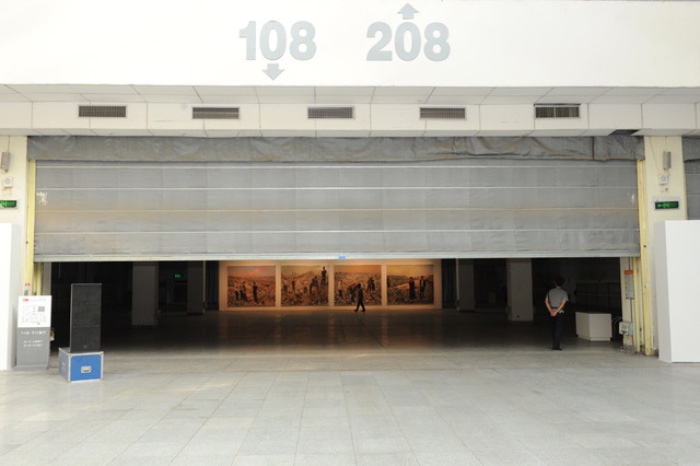
The 108 Space, Urumqi, 2012
Alongside the exhibition, there is the Xinjiang research project lead by the coordinator Ou Ning. Ou brings in total six local people who work in the cultural sector in Xinjiang, include three Han majorities, one Kazakh and two Uyghurs, to produce a section of interviews. Various of novels, traditional instrument and ethnic languages studies are presented in the conversations, it gives a fresh appearance to introduce the local history, culture, and cultural geopolitics between two regions. There were also two symposiums organized in both Urumqi and Beijing. Little warm and touched detail caught the attention was the traditional Xinjiang carpet placed in the middle of the conferences. People could sit on it while listening or doing the presentations. This small feature connected people cross different culture and daily lives. It was one of starting points towards the cultural communication, although the interviews did not dig these themes in depth, questions from Ou show an obvious sign of knowledge and professional lacking within the topics. Despite the given political condition, it would be more diverse to approach the theme not only limited to the superficial inquiries about literatures and music, but through a solid research in socio-political, artistic, religious and historical perspectives.
Hou said in many interviews, he likes to draw a general picture of projects and let them evolve by themselves. Who says the alienation between the artist/his team and the local minorities does not show a complete overview of the socio-political reality in Xinjiang? It is the sad part of the story. Many people were attracted by Liu Xiaodong’s fame and position, but few were aware and care the intention behind the curatorial conception and the theme. Take the Xinjiang issue as an example, the ethnic separation has already started since Qing Dynasty [1644-1912] (Wang Ke, 2013). Although there were a long tradition of exchanges between Xinjiang and other regions in China (Rémi Castet, 2003), the reality are formed together with the foreign political and cultural influences from the UK, Turkey and the USSR, the oppositions between the upper echelons in the region, and the contradiction within the Islamic religious branches (Wang Ke, 2013); it contains much more cultural-political and historical complexities and impacts than the few live-paintings and “cultural” conversations could show. This reflects to a critical thinking: how can a micro-narrative perspective truly represent or intervene into the current geopolitical and cultural complexity, without over-layering a fraction of the reality? It brings us to the challenges that Hou and many projects are facing at the turning moment of globalization and under the intertwined crises.
In 2021, artist Liu Yujia (born in 1981) and her project Border Hotel (2021) have caught my attention. The show is located at the Diplomatic Residence Compound in Beijing, which was constructed in 1971 as China’s first international office and residence compound for the overseas staff of embassies, international organization and new agencies. The space itself adds an interesting backstory context to the exhibition. The project, on theoretical side, presents two threads: firstly, the archaeological excavation of the Hungarian-British archaeologist Sir Aurel Stein in China’s frontier region in the late 19th and early 20th century; together with his research and photo archives that include ethnography, for instance, with a distinct racism and colonial tinge. Secondly, the social, cultural and economic transformations in Xinjiang under the policy of China Western DevelopmentIV since 1999. However, on another side, the artist seems would like to play an archaeological puzzle game with the viewer through burying layers of clues and metaphors.
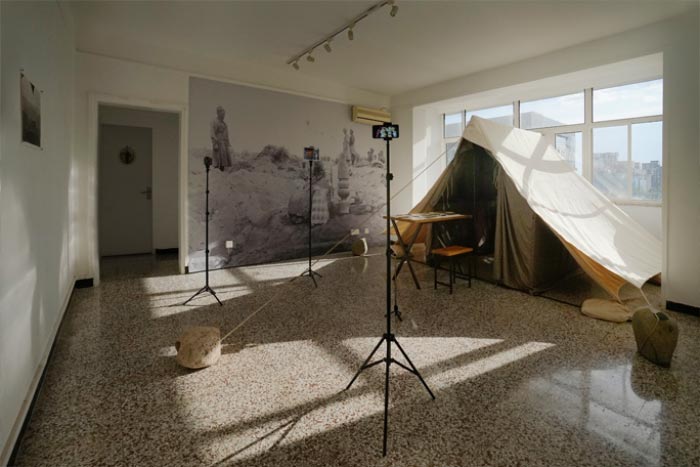
One of the video works from Border Hotel, single channel video, Liu Yujia, 2021
Contrasting was the main methodology in this project, leaving certain spaces for reflections is also a way of expression. By comparing the discourses of the past and the present, it raises the question of what is the real value of Xinjiang as a frontier and region nowadays. For instance, in the living room of the space, a full-wall size photograph of the excavation site that Stein discovered in the Damagou area of Hotan; his manuscripts, archaeological archives and living tent has been restored. These figures are presented in juxtaposition with four smartphone-boradcast stands with Huawei smartphone and iPads continuously playing videos of jade market trading records in Hotan. These videos are so loud and noisy, they show the scenes of Han businessmen live-steam the process of buying stones from Uyghur jade suppliers through WeChat, TikTok and Kwai software in dirty environments. Very less respects and trusts from both sides of the people can be found, but faces of boredom, numbness and greed. They shouted with only numbers, the numbers represent money of course, scrambling the jade raw materials by their hands until they reached agreements.
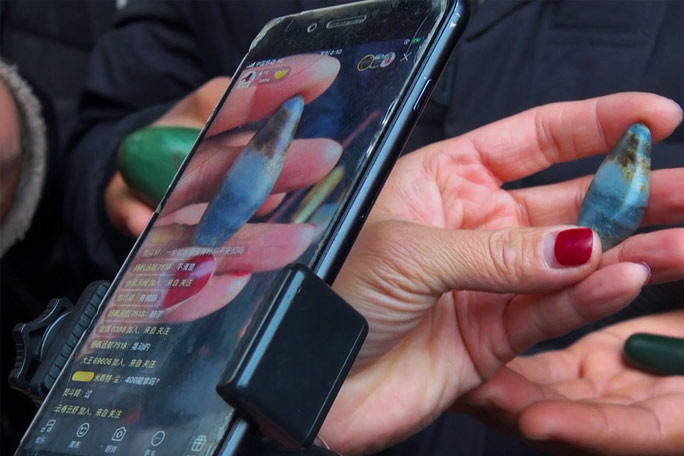
Installation view of Border Hotel, 2021
Another example is in a room on the north side of the space. On the wall there is a single-channel video work titled Archaeological Journal – Topographic Exploration of the Riverbed (2020-2021). The dry riverbed in the video is bleak and covered with a gray fog, and the mechanism of those uneven stones looks like a layer of diseased skin, sits between the wound of the earth. Uyghurs in pairs are digging jades among the broken lands. The only bright colors in the video are those woolen flowers on the heads of the mining women and the glitters on their clothes. In front of this piece, outside of the window, a monitor on the balcony plays another video of an Uyghur man shaving during or after his work in front of camera. On his face that has been tortured by the weather and living condition, there are still some traces of handsomeness remain; although he is in a haded 80s hat and an oversized suit. He shaves his cheeks over and over again, like an action of revolt. In the middle of the room, a table with a set of archival photographs of anthropometry that Stein took during his ethnographic surveys in the vast Kunlun Mountains in the early 20th century. The people in the photo look lost and confused. They were neatly lined up in rows, like experimental objects with numbers. These three kinds of information are displayed at the same time, in the same room, forming a sharp contrast and strong impact. It constitutes a silent but unforgettable socio-political and historical narrative.
The whole exhibition is filled with an eerie vibe. It has a positive attitude yet full of discordant awkwardness. The single-channel video work A Music Lesson – Song of Motherland (2020-2021) in the entrance renders the atmosphere from very beginning. What we can see is a group of Uyghur young people (from 15-30 years old maybe) is chanting Song of Motherland, a red patriotism song, in their own ethnic language. Some of them are excited, some are looking left and right, and some are just there to complete the task. The weird thing is that, in addition to reading the lyrics in their hands, they have been continually staring at the top left of the camera as if looking for some kind of affirmation. The singing is repeated over and over, loudly.
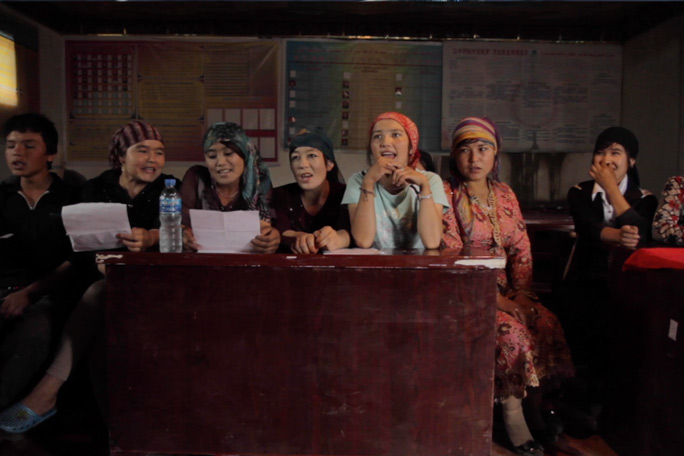
A Music Lesson – Song of Motherland, single channel video, Liu Yujia, 2020-2021
Furthermore, The Pale View of hills (2018) is the most interesting piece in the show in my opinion. It illustrates the daily labor of the Kucha Patriotic Prince’s widow, and this set of videos are showcased in the toilet and kitchen of the exhibition space. The princess, Reyanam Dawnt, different from what people may think, is a middle-aged woman with a numb, puffy and cautious face. The only information can be found about her is that she married the 70 years old prince when she was in her 30s. In the footage, the princess’ big and swollen body is reluctantly stuck under cheap and colorful ethnic costumes. She is constantly scrubbing and tidying up the houseworks in her toilet, living room and kitchen, yet, the house she is living is not her house but a public museum that opens to tourists. The video recorded her daily work: shaking hands with different tourists, smiling and taking pictures under the wall covered with pennants and photos of her husband. Then she can get her payment — three Euros per person, whereas she can only keep sixty percent, the rest has to hand to the museum. The princess is professional, she performs well: she is warm, polite and patient. But while waiting for the guests, her eyes occasionally showed looks of depression and loneliness. The house, or let us say the museum, looks more like a movie set. The video, or the reality, is surreal and absurd.
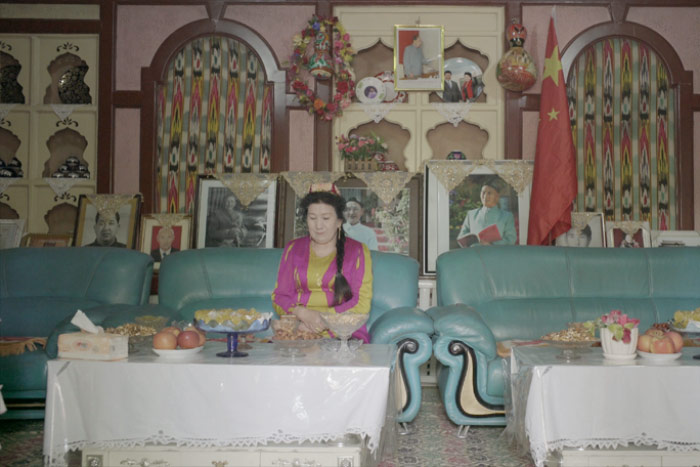
The Pale View of hills, single channel 4K video, Liu Yujia, 2018
The earliest time I went to Xinjiang was in 2015 in Karamay to shoot the work “Black Ocean”. It was the first time I went to Xinjiang, and I was completely moved by the scenery and landforms there, as well as the unusually clear and three-dimensional feeling about the time and history. So after finishing that piece, I thought I could go to other places for experiencing. Each time I travelled, I discovered new topics and subjects of interest. In post-editing process, I can find new clues again. Thus, there are more and more clues, and more and more topics that can be developed. Creation is like a treasure hunt, you probably know what you want, but you don’t know where it is or what you will end up with. The process is full of unknowns and hardships, but you will get it eventually, and it will be more than you can imagine. It’s such a constant drive for me. (Liu Yujia, 2022)
Comparing to the aforementioned project in this section, I believe Liu Yujia’s works are more closer to what I am searching for. An equal observation, a meticulous experience and serious research. Not a superficial grasping, a slogan, excessive beautification or criticism; but a real, in-depth thinking and reflection on the current context.
Conclusion
Although this article only selects a small part of my research, above mentioned projects from artists and curators not only draw margins from ethnic minorities/ frontier in nation-state levels, they as well illustrate a certain range of cultural and political center in China, because the periphery also defines the center in a sense. Art is an individual choice, artists and curators follow their instincts which lead them to explore the meaning of history, time, space and reality. These works play an intermediary role in the dialogue between society and culture, as well as elucidate the differences of identities and historical backgrounds. Event though everyone’s creative angle and point of view are different, their expressions represent the margins of the society without making peace with the hegemonic center. The projects have intervened into our social reality.
When we talk about margins, what we always associate are risks (Alejandro Morales, 1995). There is an inspiring historical concept worth mentioning at the end, it has been discovered through conversations while the research has been doing: how Christianity developed and expanded in the Roman Empire. The Edict of Milan did not just legalized Catholicism at the time, it also made several changes in order to make it adapt to the rulers and the Roman society. Therefore, the Catholicism has transferred from the margins or “danger” at the time step by step to the new center. This theory, however, can be also applied to the margins to contemporary China. For example, Xinjiang issues have attracted many attention in the global stage nowadays, whereas it also brings many big Capital investments for art and cultural activities in Xinjiang, such as the ethnic culture influenced fashion magazine covers, the establishment of Xinjiang Festival 2021 and the Gaotai Art Center, etc. For those young people, going to Xinjiang to attend the art and cultural activities has somehow become a new mainstream trend in 2021, of course, until a certain extend. Furthermore, the works of Lu Nan that illustrate the happy and simple lifestyle of Tibetans, and the nomadic movement advocated by Inner Mongolian and Han artists to return to nature, which also directly reflect the current social anxiety and high pressure in the urban areas and yearnings for well-living.
The relationship between center and margins is a complex issue with multi-dimensional aspects, as the article addressed. James Anderson and Liam O’Dowd argue that, “instead of becoming redundant in a ‘borderless’ world, the increasing differentiation, complexity and contradictions of political borders make border search more important and more revealing of wider social change (James Anderson & Liam O’Dowd, 1999:603)”. What is now margins can be tomorrow closer to the center, especially in contemporary art. I believe artworks should not be “timeless”, but in the conversation now, in the present, about this time, our time. Studying and archiving artists and their works that portrait the margins of Chinese society might bring us insides of key debates in the contemporary world in the near future. Moreover, this article is not an end, but a fresh beginning: there are many more relevant and interesting artists, curators and institutes that deserve to be explored, more interviews and field research will be done and more data will be collected, analyzed and developed.
References
Anderson, Jame and Liam O’Dowd, “Borders, Border Regions and Territoriality: Contradictory Meanings, Changing Significance”, in Regional Studies, 33 (7), 1999, pp. 593-604.
Castets, Rémi, “The Uyghurs in Xinjiang – The Malaise Grows”, China Perspectives 2003/9-10, 2003, pp.49.
Dunham, Carroll, Into Words: The Selected Writings of Carroll Dunham, Badlands Unlimited, New York, 2017.
Elliott, Mark, C., The Manchu Way: The Eight Banners and Ethnic Identity in Late Imperial China, Stanford University Press, California, 2002.
Laing, Olivia, The Lonely City: Adventures in the Art of Being Alone, Canongate, Edinburgh, 2016, pp.32.
Leibold, James and Danielle Xiaodan Deng, “Segregated diversity: Uyhur residential patterns in Xinjiang, China”, in A. Hayes, & M. Clarke, eds., Inside Xinjiang: Space, Place and Power in China’s Muslim Far Northwest, New York: Routledge, 2016, pp.122-134
Liu Xiaoyuan, Frontier Passages: Enthnopolitics and the Rise of Chinese Communism, 1921-1945, The Chinese University Press, Hong Kong, 2018.
Morales, Alejandro,“Dynamic Identities in Heterotopia”, in Bilingüe Review/ La Revista Bilingüe, Vol.20, No.3, 1995, pp. 14-27.
Saltz, Jerry, How To Be An Artist, Octopus Publishing Group, Lewes, 2020, pp.12-45.
Wang Ke, East Turkestan Independence Movement: 1930s to 1940s, The Chinese University Press, Hong Kong, 2013.
Wang Ke, Minorities in Modern China, The Chinese University Press, Hong Kong, 2017.
Winckemann, Johann, J., Reflections on the Imitation of Greek Works in Painting and Sculpture, Open Court Publishing Company, Chicago, 1987, pp.64.
Zeng Qunkai, 感官,摩登与绿洲 Ganguan, Modeng yu Lüzhou (Sensuality, Modernity and Oasis), AAA, Hong Kong, 2021.
Notes
I The Chinese economic reform or reform and opening up, know in the opening of China, is the program of economic reforms termed “Socialism with Chinese characteristics” in the PRC.
II Long March Project is a curatorial and institutional practice from the Long March Space, initiated in 1999 and begun in 2002.
III The 5th of July 2012 is the third anniversary of deadly ethnic related violence that almost 200 Han majority civilians including children were killed in 2009.
IV China Western Development is a policy from the CCP for pushing the economical development that covers 6 provinces, 5 autonomous regions and 1 municipality in the northwest of China.
V Islamic male believers in southern Xinjiang are not allowed to grow beards because of ‘religion de-radicalization’ policy of the CCP.
